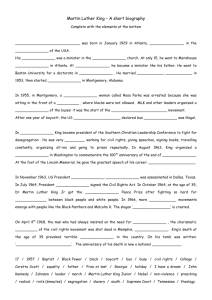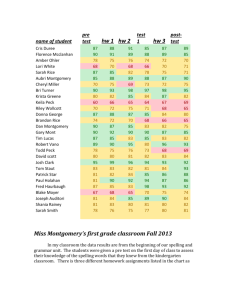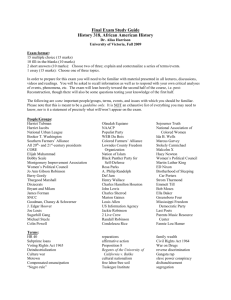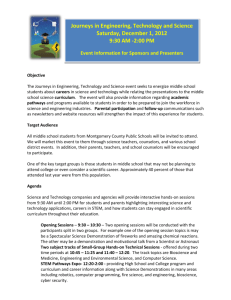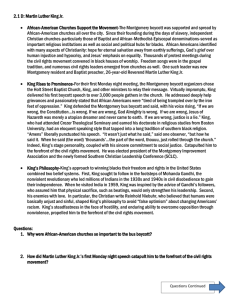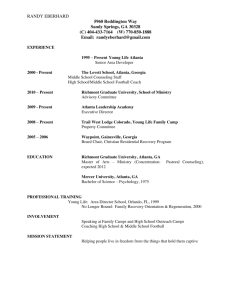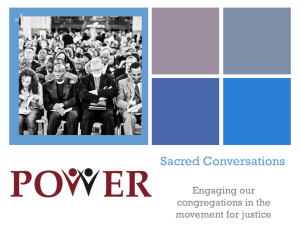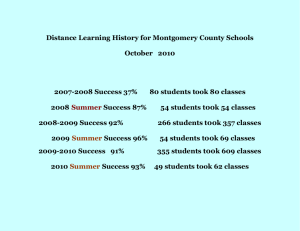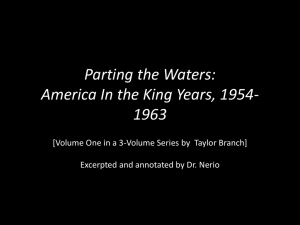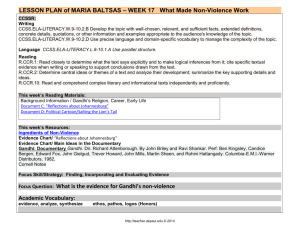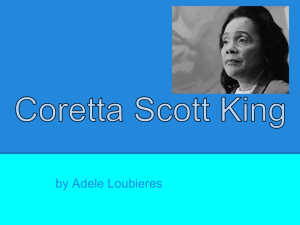Outline: “Martin Luther King, Jr.: The Man and the Dream” (A & E
advertisement
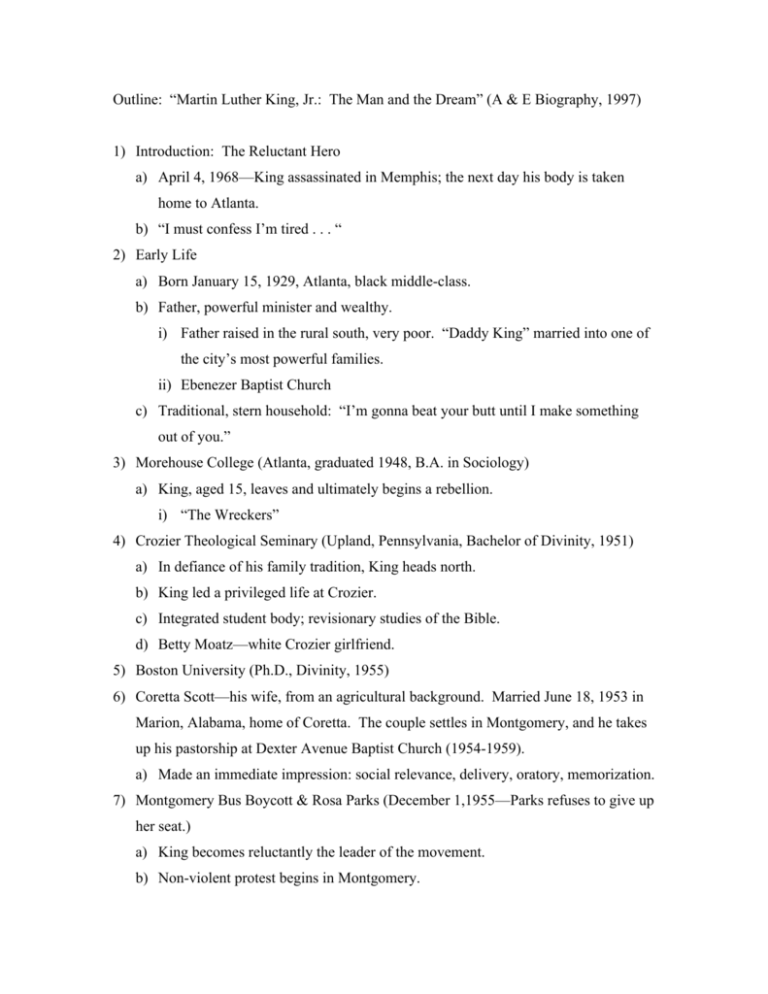
Outline: “Martin Luther King, Jr.: The Man and the Dream” (A & E Biography, 1997) 1) Introduction: The Reluctant Hero a) April 4, 1968—King assassinated in Memphis; the next day his body is taken home to Atlanta. b) “I must confess I’m tired . . . “ 2) Early Life a) Born January 15, 1929, Atlanta, black middle-class. b) Father, powerful minister and wealthy. i) Father raised in the rural south, very poor. “Daddy King” married into one of the city’s most powerful families. ii) Ebenezer Baptist Church c) Traditional, stern household: “I’m gonna beat your butt until I make something out of you.” 3) Morehouse College (Atlanta, graduated 1948, B.A. in Sociology) a) King, aged 15, leaves and ultimately begins a rebellion. i) “The Wreckers” 4) Crozier Theological Seminary (Upland, Pennsylvania, Bachelor of Divinity, 1951) a) In defiance of his family tradition, King heads north. b) King led a privileged life at Crozier. c) Integrated student body; revisionary studies of the Bible. d) Betty Moatz—white Crozier girlfriend. 5) Boston University (Ph.D., Divinity, 1955) 6) Coretta Scott—his wife, from an agricultural background. Married June 18, 1953 in Marion, Alabama, home of Coretta. The couple settles in Montgomery, and he takes up his pastorship at Dexter Avenue Baptist Church (1954-1959). a) Made an immediate impression: social relevance, delivery, oratory, memorization. 7) Montgomery Bus Boycott & Rosa Parks (December 1,1955—Parks refuses to give up her seat.) a) King becomes reluctantly the leader of the movement. b) Non-violent protest begins in Montgomery. 2 8) Imprisonment and Incarceration—King put to the test. a) King’s house bombed, January 30, 1956. i) Non-violence his response . . . ii) The boycott takes protest from the courts to the streets, much like Gandhi in South Africa. b) The New Negro—“The New Negro is a person with a new sense of dignity and destiny, with a new self-respect; along with that, there’s this lack of fear, which once characterized the Negro.” 9) The New Media Profile / The Lessons of Montgomery a) Begins traveling and speaking for Civil Rights. b) Perceived as threat and rival to NAACP. c) 1958—promoting his book, Stride toward Freedom, in New York when a black woman stabs him. American celebrity-hood descends upon him. d) February 9, 1959, King travels to India for a month-long homage to non-violence. 10) Greensboro, North Carolina (February 1, 1960, Woolworth’s)—Four AfricanAmerican students launch the sit-in at the lunch counter, and the movement spreads. a) King immediately recognizes the power of this action (like Gandhi again in South Africa discovering mass incarceration). b) Many blacks in Atlanta, and Daddy King as well, were against the lunch-counter movement; and the students wanted his participation. c) Rich’s Department Store—King arrested, transferred to Reedsville Penitentiary. 11) Kennedy and Harry Belafonte, 1960 a) Belafonte steers him toward King. b) The Kennedy call to Coretta: King released. c) An uneasy relationship begins. 12) The Freedom Rides—designed to challenge local segregation laws by riding various forms of public transportation that had remained segregated. The first such Freedom Riders left D.C. on May 4, 1961 and were scheduled to arrive in New Orleans on May 17. a) Anniston, Alabama, May 14, 1961, one bus fire-bombed. 13) Birmingham (Spring 1963)—Eugene Bull Connor –child demonstrators. 3 a) A series of sit-ins and marches designed to engender mass arrests. b) Images of the protests and retaliation went world-wide and King emerges as the leader of the Civil Rights Movement. 14) March on Washington (August 28, 1963; 250,000 participants). a) King delivers his “I Have a Dream” speech. 15) Stanley Levison—member of the Communist Party of the USA in the 50’s. a) JFK gives Hoover—Director of FBI—authorization to wiretap King. b) Even after JFK’s death, the wiretaps continued, and the FBI followed him from town to town, and there was evidence discovered of indiscretions. 16) Nobel Peace Prize, 1964. 17) Selma & Sheriff Jim Clark. a) March 7, 1965, “Bloody Sunday”—having captured the attention of the nation and the world, King marched again from Selma to Montgomery with 50,000 people. i) This was King’s Salt March . . . ii) And it caused him to expand his movement to include the poor. 18) King Moves the Movement to the North. a) Los Angeles—King heard a new language, attributed to Malcolm X: “We are not non-violent with anyone who is violent with us.” b) From 1966-68, he becomes increasingly defensive regarding, particularly, nonviolence. c) Attacked by liberals and conservative for his anti-war stance, he resembles Gandhi urging non-violence between Muslims and Hindus, standing alone. 19) “Beyond Vietnam”—Riverside Church, New York City, April 4, 1967. 20) April, 1968—Invited to Memphis to address the striking sanitation workers, a subject that fit into his developing ideas about the gap between rich and poor. a) April 3, 1968—“The Mountaintop” speech. b) April 4, 1968—Lorraine Motel—Room 306. c) April 5, 1668—Robert Kennedy’s speech, “The Mindless Menace of Violence.” d) “Why America May Go to Hell”—proposed title for his last sermon.
